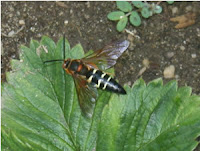The problem is the wasps are back this year and now have spread to my yard. We’re starting to think that leaving them alone might not be the best idea.
I understand that Cicada Wasps are beneficial insects.
I understand that they will not sting me.
I understand that they will only be a nuisance for about a month
I’d still prefer them to find some other place to do their business.
The question is how do I get rid of them? After doing some research, I've learned that Cicada Killer Wasps like to make their nests in bare, dry, unfertilized soil. In the Northeastern US, they are active for about one month, from mid-July to mid-August. The wasps you see swarming around during the day are males. Males do not have a stinger so they can’t harm you. The female has a stinger but probably won’t sting you unless you actually step on her. Cicada Wasps can be hard to get rid of because you have to kill the wasps as well as the eggs the female leaves inside the nest.
After reading a few really interesting articles by people in the “bug” field, I’ve determined that one or all of the following methods should get rid of them.
Method 1: Poison the wasps while they are in the nest
Locate the nests. The nest will look like a small pile of soil with a hole in the middle. There will probably be more than one. Mark the location so that you’ll be able to find it in the dark. A good way to do this is to stick a white plastic knife in the ground right next to the hole. Wait until dark when the wasps have gone into the nest. Using a flashlight, find the marked nests and pour ammonia or wasp insecticide into the nest. Keep in mind that this method will probably kill the wasps, but may not kill the eggs.
Method 2: Swat them
Use a Badminton racquet to swat the wasps while they are flying around. The males can’t hurt you because they don’t have a stinger. And, they aren’t very fast so you should be able to get them. It sounds a little crazy, but many people swear by this method. The downside is that eggs in the nest will hatch next year.
Method 3: Flood them out
Locate the nests as in Method 1. Wait until dark and pour boiling water into the nest. Plug up the hole with a stick or rock. Over the next few days keep the area wet. This will make the area less attractive to any new wasps.
I’ve tried Methods 1 and 3 and both seem to have worked. I haven’t tried Method 2 because I don’t have a Badminton racquet (at least that’s the excuse I’m sticking with). If they return next year, and everything I’ve read suggests that they will, I will definitely try the swatting method. But, more important than how to kill them is how to keep them from wanting to come here in the first place.
This is what I’ll be doing to prevent them from nesting:
- Mow the lawn with the highest setting
- Use thick wood chip mulch or stones in garden beds
- Fertilize the soil
- Don’t allow the soil to become dry





